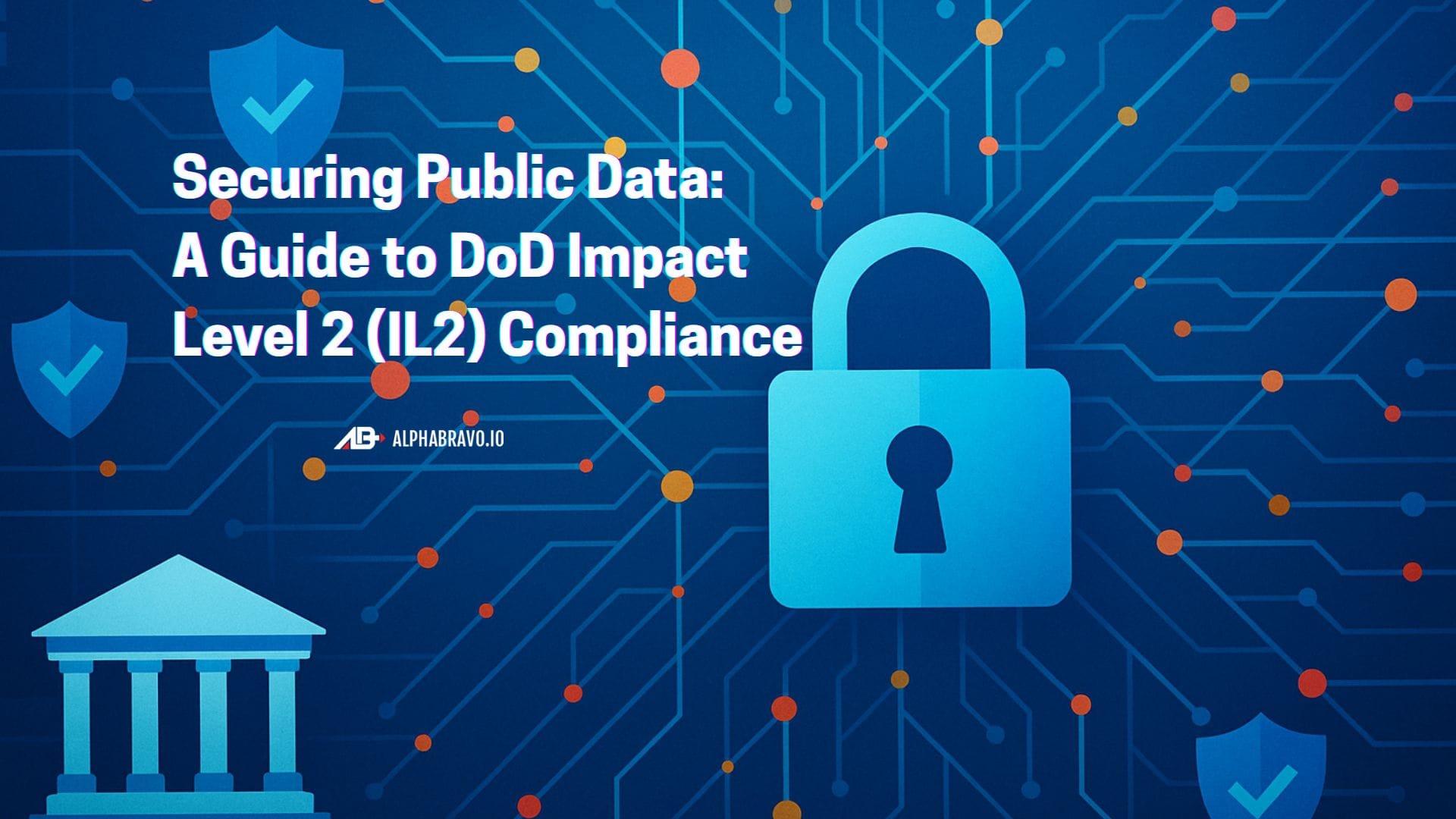Securing Public Data - A Guide to DoD Impact Level 2 (IL2) Compliance
DoD Impact Level 2 compliance offers cloud providers a streamlined, FedRAMP-aligned path to serve federal missions with secure, public-facing applications—balancing accessibility, compliance, and opportunity.

The Department of Defense (DoD) has established a structured framework for securing cloud-based information systems through a series of Impact Levels (ILs). Among these, Impact Level 2 (IL2) serves as the foundation for protecting publicly releasable and non-sensitive information. Organizations seeking to provide cloud services to DoD entities must navigate these compliance requirements to ensure proper data protection while maintaining accessibility. This comprehensive guide explores IL2 compliance, its security requirements, and implementation strategies for cloud service providers (CSPs) looking to serve DoD customers.
Understanding DoD Impact Level 2
DoD IL2 represents the lowest authorization level within the DoD Cloud Computing Security Requirements Guide (CC SRG) framework, designed specifically for public and non-critical mission information. This classification encompasses two primary categories of data:
- Publicly releasable information cleared for public release
- Non-public unclassified information with low sensitivity not designated as Controlled Unclassified Information (CUI)
The Defense Information Systems Agency (DISA) defines IL2 data as information where "the unauthorized disclosure could be expected to have a limited adverse effect on organizational operations, organizational assets, or individuals". This categorization aligns with Committee on National Security Systems Instruction (CNSSI) 1253 at moderate Confidentiality, Integrity, and Availability (C-I-A) levels for non-CUI information.
Positioning Within the DoD Impact Level Framework
IL2 serves as the entry point in the DoD's graduated security model:
- IL2: Public and non-critical mission information
- IL4: Controlled Unclassified Information (CUI)
- IL5: Higher-sensitivity CUI and National Security Systems
- IL6: Classified information up to SECRET level
It's worth noting that there are no Impact Levels 1 or 3 in the current framework. IL1 was eliminated because public data without security concerns doesn't require categorization, while IL3 has been consolidated into IL4 for framework streamlining.
FedRAMP Moderate Alignment and Security Controls
A cornerstone of IL2 compliance is its direct alignment with the Federal Risk and Authorization Management Program (FedRAMP) Moderate baseline. This alignment establishes reciprocity between the two programs, significantly streamlining the authorization process for cloud service providers.
Control Requirements and FedRAMP Reciprocity
DoD IL2 leverages the FedRAMP Moderate security control baseline as established in NIST Special Publication 800-53. This baseline currently consists of 325 security controls under Revision 4, though the transition to Revision 5 may adjust this number to approximately 323 controls.
The reciprocity between FedRAMP Moderate and DoD IL2 creates a valuable pathway for CSPs:
"All cloud service offerings (CSOs) granted a FedRAMP Moderate or High authorization are automatically granted DoD IL2 reciprocity".
This reciprocity is formalized through a DISA-issued Provisional Authorization (PA) that enables DoD components to utilize FedRAMP Moderate-authorized cloud services for IL2 data without awaiting explicit DoD authorization. This streamlined approach significantly reduces redundant assessment efforts and accelerates time-to-market for CSPs entering the defense sector.
Key Security Requirements for IL2
The IL2 security framework includes several fundamental requirements:
- Access Controls: Implementation of basic access mechanisms such as user ID and password authentication
- Security Assessment: Meeting all 325 FedRAMP Moderate controls (or 323 under Revision 5)
- Continuous Monitoring: Adherence to FedRAMP continuous monitoring practices
- Marketplace Listing: The CSO must be listed as "Authorized" in the FedRAMP Marketplace
Implementation Strategies for DoD IL2 Compliance
Organizations seeking IL2 compliance must develop implementation strategies that address both technical and procedural requirements while maximizing the benefits of FedRAMP reciprocity.
Deployment Environments
IL2 systems can be deployed in commercial cloud environments, including major platforms offering government-focused solutions:
- Microsoft Azure Government
- AWS GovCloud
- Google Cloud Government
- Salesforce Government Cloud
- Oracle Government Cloud
Many of these providers have already obtained FedRAMP Moderate authorization, enabling them to support DoD IL2 workloads through reciprocity.
Connectivity Requirements
Unlike higher impact levels that require specialized network connections, IL2 systems can operate with standard internet connectivity:
- Access Method: Public internet
- Connection Requirements: No specialized government network connections needed
- User Base: Can support both government and commercial customers within the same IL2 cloud environment
This accessibility makes IL2 ideal for public-facing DoD applications, websites, and non-sensitive information systems.
Data Residency Considerations
The search results contain some discrepancies regarding data residency requirements for IL2. Some sources indicate that "data can reside in facilities outside the U.S. and its territories", while others suggest that "datacenters leveraged by the CSO must be in the United States or its territories".
This apparent contradiction may reflect evolving requirements or context-specific interpretations. Organizations pursuing IL2 compliance should consult the most current DoD CC SRG documentation and engage with their authorizing officials to confirm specific data residency requirements for their implementations.
Assessment and Authorization Process
The path to IL2 authorization leverages the existing FedRAMP process with specific DoD considerations.
FedRAMP Assessment Path
Organizations typically follow one of two FedRAMP assessment paths:
- Agency Authorization: Working with a specific federal agency as the authorizing official
- Joint Authorization Board (JAB) Authorization: A centralized assessment reviewed by representatives from DoD, DHS, and GSA
Both paths require assessment by a Third-Party Assessment Organization (3PAO) and result in a security authorization that can be leveraged for DoD IL2 through reciprocity.
Documentation Requirements
Key documentation required for the assessment includes:
- System Security Plan (SSP)
- Security Assessment Report (SAR)
- Plan of Actions and Milestones (POA&M)
- Continuous Monitoring Plan
These documents must thoroughly address all applicable FedRAMP Moderate controls and any DoD-specific considerations.
Annual Assessment Requirements
To maintain compliance, organizations must:
- Conduct annual third-party assessments
- Implement a continuous monitoring program
- Report security incidents promptly
- Maintain up-to-date POA&Ms
Benefits of DoD IL2 Certification
Achieving IL2 certification provides several strategic advantages for cloud service providers:
Expanded Market Access
IL2 authorization opens access to DoD contracts involving non-sensitive information and public-facing applications. This creates significant business opportunities within the defense sector without requiring the more stringent controls associated with higher impact levels.
Foundation for Higher Impact Levels
IL2 provides a foundation for organizations planning to pursue higher impact levels in the future. The infrastructure, processes, and controls implemented for IL2 can be extended and enhanced to meet the requirements of IL4 and above as business needs evolve.
Competitive Differentiation
IL2 authorization serves as a market differentiator, demonstrating a CSP's commitment to security and compliance. This credential can be particularly valuable for organizations focused on government and defense contracts.
Practical Considerations and Best Practices
Organizations pursuing IL2 compliance should consider several practical approaches to streamline the authorization process:
Leverage Existing FedRAMP Authorization
If you already have a FedRAMP Moderate authorization, you're positioned to leverage reciprocity for DoD IL2. Ensure your FedRAMP authorization is in good standing and that your CSO is properly listed in the FedRAMP Marketplace.
Engage Early with Authorizing Officials
Early engagement with relevant DoD authorizing officials can help clarify any ambiguous requirements and establish a smooth path to authorization. This engagement should address any specific implementation considerations unique to your service offering.
Implement Automation for Control Management
The substantial number of controls required for FedRAMP Moderate/DoD IL2 makes manual management challenging. Consider implementing automated compliance tools to streamline control implementation, continuous monitoring, and reporting.
Focus on Continuous Monitoring
Robust continuous monitoring is essential for maintaining compliance. Implement comprehensive monitoring solutions that provide real-time visibility into your security posture and alert on potential compliance deviations.
Future Directions for DoD Cloud Security
The DoD cloud security landscape continues to evolve, with several developments likely to impact IL2 requirements in the future:
FedRAMP Revision 5 Integration
As FedRAMP transitions to Revision 5 based on NIST SP 800-53 Revision 5, cloud service providers should anticipate changes to security control requirements. The updated baseline is expected to incorporate enhanced controls for supply chain risk management, insider threats, and privacy.
Zero Trust Architecture Alignment
The DoD's ongoing shift toward Zero Trust Architecture will likely influence IL2 requirements, potentially introducing additional controls for identity management, micro-segmentation, and continuous validation.
Enhanced Threat-Based Controls
The DoD's application of the Threat-Based Methodology in developing FedRAMP Revision 5 signals an increasing focus on controls that specifically address current threat vectors identified in frameworks like MITRE ATT&CK.
Final Thoughts
DoD Impact Level 2 represents a strategic entry point into the defense cloud ecosystem, providing a balanced approach to security for public and non-sensitive information. By leveraging FedRAMP reciprocity, cloud service providers can efficiently achieve IL2 compliance and establish a foundation for potential expansion to higher impact levels.
The alignment between FedRAMP Moderate and DoD IL2 creates a streamlined path to compliance that benefits both the government and industry, reducing duplicate assessment efforts while maintaining appropriate security controls for public and non-critical mission information.
For organizations looking to provide cloud services to DoD entities, IL2 certification offers a practical starting point that balances security requirements with implementation feasibility, creating new opportunities in the defense marketplace while ensuring proper protection of government information assets.

